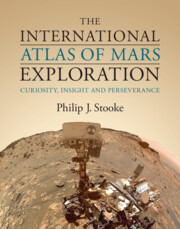Refine listing
Actions for selected content:
17002 results
31 - Accelerating Universe with a Cosmological Constant
- from Part V - Cosmology
-
- Book:
- Fundamentals of Astrophysics
- Published online:
- 10 November 2025
- Print publication:
- 24 July 2025, pp 251-259
-
- Chapter
- Export citation
Appendix C - Atomic Origins of Opacity
-
- Book:
- Fundamentals of Astrophysics
- Published online:
- 10 November 2025
- Print publication:
- 24 July 2025, pp 287-290
-
- Chapter
- Export citation
Part IV - Our Milky Way and Other Galaxies
-
- Book:
- Fundamentals of Astrophysics
- Published online:
- 10 November 2025
- Print publication:
- 24 July 2025, pp 199-240
-
- Chapter
- Export citation
24 - Water Planet Earth
- from Part III - Interstellar Medium and Formation of Stars and Planets
-
- Book:
- Fundamentals of Astrophysics
- Published online:
- 10 November 2025
- Print publication:
- 24 July 2025, pp 182-186
-
- Chapter
- Export citation
14 - Our Sun
- from Part I - Stellar Properties
-
- Book:
- Fundamentals of Astrophysics
- Published online:
- 10 November 2025
- Print publication:
- 24 July 2025, pp 90-98
-
- Chapter
- Export citation
Part I - Stellar Properties
-
- Book:
- Fundamentals of Astrophysics
- Published online:
- 10 November 2025
- Print publication:
- 24 July 2025, pp 1-98
-
- Chapter
- Export citation
9 - Stellar Space Velocities
- from Part I - Stellar Properties
-
- Book:
- Fundamentals of Astrophysics
- Published online:
- 10 November 2025
- Print publication:
- 24 July 2025, pp 54-58
-
- Chapter
- Export citation
12 - Light Intensity and Absorption
- from Part I - Stellar Properties
-
- Book:
- Fundamentals of Astrophysics
- Published online:
- 10 November 2025
- Print publication:
- 24 July 2025, pp 74-81
-
- Chapter
- Export citation
4 - Surface Temperature from a Star’s Color
- from Part I - Stellar Properties
-
- Book:
- Fundamentals of Astrophysics
- Published online:
- 10 November 2025
- Print publication:
- 24 July 2025, pp 25-31
-
- Chapter
- Export citation
Preface to the First Edition
-
- Book:
- Fundamentals of Astrophysics
- Published online:
- 10 November 2025
- Print publication:
- 24 July 2025, pp xvii-xviii
-
- Chapter
- Export citation
Dedication
-
- Book:
- Fundamentals of Astrophysics
- Published online:
- 10 November 2025
- Print publication:
- 24 July 2025, pp v-vi
-
- Chapter
- Export citation
19 - Light Intensity and Absorption
- from Part II - Stellar Structure and Evolution
-
- Book:
- Fundamentals of Astrophysics
- Published online:
- 10 November 2025
- Print publication:
- 24 July 2025, pp 128-136
-
- Chapter
- Export citation
Appendix D - Radiative Transfer
-
- Book:
- Fundamentals of Astrophysics
- Published online:
- 10 November 2025
- Print publication:
- 24 July 2025, pp 291-294
-
- Chapter
- Export citation
Appendices
-
- Book:
- Fundamentals of Astrophysics
- Published online:
- 10 November 2025
- Print publication:
- 24 July 2025, pp 279-294
-
- Chapter
- Export citation
2 - Astronomical Distances
- from Part I - Stellar Properties
-
- Book:
- Fundamentals of Astrophysics
- Published online:
- 10 November 2025
- Print publication:
- 24 July 2025, pp 11-18
-
- Chapter
- Export citation
1 - Introduction
- from Part I - Stellar Properties
-
- Book:
- Fundamentals of Astrophysics
- Published online:
- 10 November 2025
- Print publication:
- 24 July 2025, pp 3-10
-
- Chapter
- Export citation

The International Atlas of Mars Exploration
- Curiosity, InSight and Perseverance
-
- Published online:
- 13 June 2025
- Print publication:
- 22 May 2025
Bibliography
-
- Book:
- The International Atlas of Mars Exploration
- Published online:
- 13 June 2025
- Print publication:
- 22 May 2025, pp 596-610
-
- Chapter
- Export citation
Mars mission data
-
- Book:
- The International Atlas of Mars Exploration
- Published online:
- 13 June 2025
- Print publication:
- 22 May 2025, pp 591-595
-
- Chapter
- Export citation
Contents
-
- Book:
- The International Atlas of Mars Exploration
- Published online:
- 13 June 2025
- Print publication:
- 22 May 2025, pp vii-vii
-
- Chapter
- Export citation
